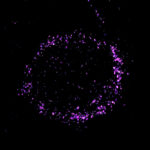In zebrafish, a way to find new cancer therapies, targeting tumor promoters

The lab of Leonard Zon, MD, has long been interested in making blood stem cells in quantity for therapeutic purposes. To test for their presence in zebrafish, their go-to research model, they turned to the MYB gene, a marker of blood stem cells. To spot the cells, Joseph Mandelbaum, a PhD candidate in the lab, attached a fluorescent green tag to MYB that made it easily visible in transparent zebrafish embryos.
“It was a real workhorse line for us,” says Zon, who directs the Stem Cell Research Program at Boston Children’s Hospital.
In addition to being a marker of blood stem cells, MYB is an oncogene. About five years ago, Zon was having lunch at a cancer meeting and, serendipitously, sat next to Jeff Kaufman, who was also interested in MYB. Kaufman was excited to hear about Zon’s fluorescing MYB zebrafish, which can be studied at scale and are surprisingly similar to humans genetically.
“Have you ever heard of adenoid cystic carcinoma?” he asked Zon.
Targeting a cancer driver
Leaving a career in finance, Kaufman founded the Adenoid Cystic Carcinoma Research Foundation with his wife, Marnie, in 2005, after she felt a lump under her jawline and was diagnosed with the rare, often deadly malignancy. (ACC usually starts in the salivary glands, but can also appear in the larynx, trachea, lacrimal gland, breast and vulva.) Finding very little ongoing research on ACC, the Foundation began creating tissue repositories and funding studies.
“What we’ve learned over 12 to 13 years is that MYB is the main driver of ACC,” Kaufman says. At the luncheon, he asked Zon: “Do you think you could shut off the MYB gene by giving chemicals to your zebrafish?”
Zon and his colleagues agreed to try, with the Foundation providing grant support. Their findings, reported last week in the Journal of Experimental Medicine, have laid the groundwork for a clinical trial in patients with ACC at the Dana-Farber Cancer Institute. More broadly, they suggest the power of zebrafish as tools for cancer drug discovery.
Turning off the green
Despite more than 30 phase II clinical trials since 1985, there is no standard chemotherapy or drug regimen for ACC. About half of all patients develop metastatic disease, and no drug therapy has been shown to prolong overall or progression-free survival.
Zon, Mandelbaum and colleagues set up a high-throughput drug screening system. They loaded tiny zebrafish blastomeres — very early embryos consisting of just a few cells — into 384-well plates. Each embryo’s MYB genes were tagged with green fluorescent protein. The team then systematically exposed the blastomeres to 3,840 small molecules. Using an automated cell imaging system, they looked to see if any chemical would “shut off the green.”

“We could have done the screen in whole embryos, but the cell culture system was so much faster,” says Zon. “We were able to do a screen in six months, versus what might’ve taken one and a half years with whole embryos.”
In the end, 22 chemicals shut off MYB, of which retinoic acid or derivatives of retinoic acid were the most potent. Retinoic acid, best known as an acne treatment, is a derivative of vitamin A.
Slowing tumor growth
The team further validated retinoic acid’s efficacy in human tumor cells. Since no one has been able to create a viable ACC cell line, the team turned to a human myeloid leukemia line, which also expresses MYB at high levels. Retinoic acid not only downregulated MYB, but did so within just one hour.
Finally, through the Foundation, the team collaborated with South Texas Accelerated Research Therapeutics (START) to test retinoic acid in “primagraft” models — live mice bearing tumors derived from actual ACC patients. They showed that retinoic acid (specifically, a preparation called ATRA) slowed tumor growth.
“With the tumor, the gas pedal is all the way down,” says Zon. “When you give retinoic acid, it takes the foot off the pedal.”
We were able to do a screen in six months.” — Leonard Zon, MD
Finally, the team worked out how retinoic acid works. In ACC, a chromosome rearrangement brings MYB adjacent to another gene, NFIB, which has an “enhancer” region. The genes bind together and NFIB’s enhancer causes MYB to get stuck “on,” so the cell makes more and more of the oncogene. But Zon’s group found that when the cell’s retinoic acid receptors are triggered by retinoic acid, they bind to the NFIB enhancer and thereby shut down most MYB production.
“Len’s work is incredibly exciting, because this is really the first drug that appears to directly target MYB, and we really haven’t had any drug that has effectively done that before,” says Kaufman. “Through our preclinical drug screening program and mouse models of ACC, we have screened over 100 anticancer agents, and we’ve very seldom seen a drug as active as retinoic acid.”
Clinical trial on deck
Mandelbaum and Zon, part of the Division of Hematology/Oncology at Boston Children’s and Dana-Farber, presented the study results at a meeting of Dana-Farber head and neck oncologists. They were equally excited. “We’re all in agreement to do a clinical trial,” says Zon.
Since retinoic acid and ATRA are old drugs no longer protected by patent, drug companies are unlikely to sponsor such a trial, so the team has a proposal out for foundation funding. The plan is to test ATRA in 12 Dana-Farber patients with ACC. ATRA has already been used to treat promyelocytic leukemia, so the ACC patients would receive the same doses. Zon thinks the trial could begin within a year.
“If it turns out to be effective, you’ve got a drug that’s been given to thousands and thousands of patients with a known safety profile,” says Kaufman. “The hope is that it will get moved fairly quickly into the clinic.”
A versatile cancer discovery platform
Alterations in MYB have been implicated in a variety of cancers, including leukemia, pediatric gliomas, and cancers of the colon, breast and prostate. But the applicability of the zebrafish test system potentially goes even further.
“Potentially, if the cancer is driven by a particular gene, you could use that in a zebrafish model, create a reporter, do a chemical genetic screen and then look at tumor inhibition,” says Mandelbaum, first author on the paper. “Chemical screening in zebrafish is a very powerful and fast system.”
Other supporters of the study include the Harvard Stem Cell Institute, the Howard Hughes Medical Institute and the National Institutes of Health. See the paper for a complete list of funders and authors.
Related Posts :
-

A new druggable cancer target: RNA-binding proteins on the cell surface
In 2021, research led by Ryan Flynn, MD, PhD, and his mentor, Nobel laureate Carolyn Bertozzi, PhD, opened a new chapter ...
-

Forecasting the future for childhood cancer survivors
Children are much more likely to survive cancer today than 50 years ago. Unfortunately, as adults, many of them develop cardiovascular ...
-

Pediatric high-grade gliomas: Research reveals effective targeting with avapritinib
Pediatric high-grade gliomas, particularly H3K27M diffuse midline gliomas (DMG), are aggressive malignant brain tumors with a poor prognosis. ...
-

Blood across our lifetimes: An age-specific ‘atlas’ tells a dynamic story
The stem cells that form our blood, also known as hematopoietic stem cells (HSCs), are with us throughout our lives. ...





